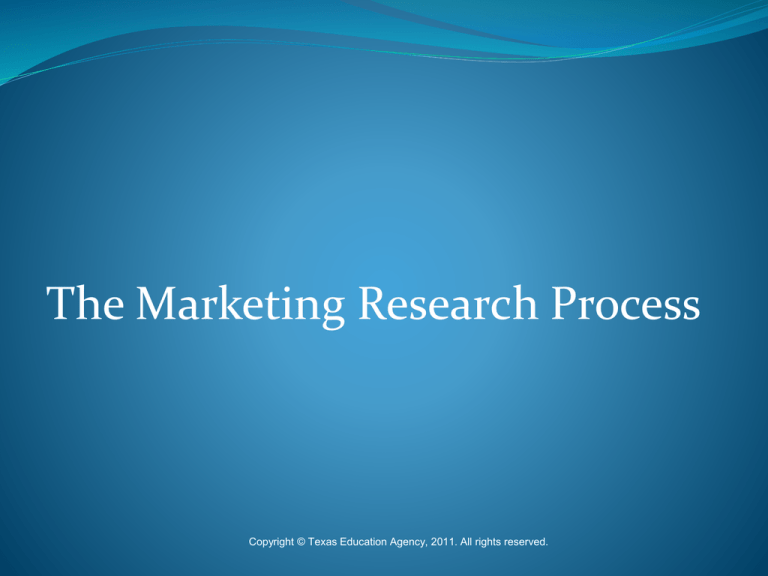
The Marketing Research Process
Copyright © Texas Education Agency, 2011. All rights reserved.
Copyright and Terms of Service
Copyright © Texas Education Agency. The materials found on this website are copyrighted © and trademarked ™ as
the property of the Texas Education Agency and may not be reproduced without the express written permission of the
Texas Education Agency, except under the following conditions:
1) Texas public school districts, charter schools, and Education Service Centers may reproduce and use copies of the
Materials and Related Materials for the districts’ and schools’ educational use without obtaining permission from the
Texas Education Agency;
2) Residents of the state of Texas may reproduce and use copies of the Materials and Related Materials for individual
personal use only without obtaining written permission of the Texas Education Agency;
3) Any portion reproduced must be reproduced in its entirety and remain unedited, unaltered and unchanged in any
way;
4) No monetary charge can be made for the reproduced materials or any document containing them; however, a
reasonable charge to cover only the cost of reproduction and distribution may be charged.
Private entities or persons located in Texas that are not Texas public school districts or Texas charter schools or any
entity, whether public or private, educational or non-educational, located outside the state of Texas MUST obtain written
approval from the Texas Education Agency and will be required to enter into a license agreement that may involve the
payment of a licensing fee or a royalty fee.
Copyright © Texas Education Agency, 2011. All rights reserved.
2
Market Research
When information is gathered that is very specifically
focused on a single target market
Steps in Marketing Research
Discover and define the problem.
Analyze current conditions.
Develop the process for data collection.
Collect the data.
Analyze and report the data.
Determine a solution to the problem.
Implement and evaluate the results.
Copyright © Texas Education Agency, 2011. All rights reserved.
3
Step 1: Discover and Define the
Problem
Exploratory Research-conducted when a business is
unaware of the exact problem (television network
conducts research to determine why fewer people are
watching a particular show)
Desk Research-where reports of other completed
research are used to help define the problem
Copyright © Texas Education Agency, 2011. All rights reserved.
4
Step 1: Discover and Define the
Problem
Descriptive Research-is used when the business is aware of
the problem that needs to be solved (if a group wants to
start a new professional soccer team, it needs to know if
there will be a sufficient fan base to support the team)
Causal Research-used to determine cause-and-effect
relationships when the problem is already clearly defined
(when the sports team’s marketing department does not
know which of two team logos and colors will motivate fans
to buy more team merchandise, research can help
determine the effect of each alternative)
Copyright © Texas Education Agency, 2011. All rights reserved.
5
Step 2: Analyze Current Conditions
Look at sales volume.
Analyze customer data to understand current
conditions.
Copyright © Texas Education Agency, 2011. All rights reserved.
6
Step 3: Develop the Process for
Data Collection
Observation
Conducting a Survey
Personal Interviews with Customers
Copyright © Texas Education Agency, 2011. All rights reserved.
7
Step 4: Collect the Data
Use e-mail to contact season ticket holders
Survey a sample-a small number representative of the
large group
Copyright © Texas Education Agency, 2011. All rights reserved.
8
Step 5: Analyze and Report the
Data
Electronically compile responses.
Look for patterns in the data.
Draw conclusions based on the patterns.
Track sales.
Determine price points-the range of prices charged for
a category of merchandise
Spreadsheets and database software help sort
thousand of bits of data and make sense of the data
Charts and graphs-visual representation of results
Copyright © Texas Education Agency, 2011. All rights reserved.
9
Step 6: Determine a Solution to the
Problem
Based on Conclusions from the Data
Make Recommendations
Copyright © Texas Education Agency, 2011. All rights reserved.
10
Step 7: Implement and Evaluate
the Results
Concerns might be uncovered.
Companies implement the changes to determine
whether they actually result in an effective solution to
the problem.
Copyright © Texas Education Agency, 2011. All rights reserved.
11
Human Factor of Marketing
Research
Research Sophistication
Gut feeling and intuition
Research is valued and actively used to make decisions
Decisions based on sound information
Reducing Conflict
Research results may indicate the need for change
Managers should not “shoot the messenger.”
Research that indicates unhappy customers-presents
opportunities for departments to work together for the
best solution
Copyright © Texas Education Agency, 2011. All rights reserved.
12
Human Factor of Marketing
Research
Ethical Research
Report information accurately and objectively
Biased research is inaccurate research
Obligation to protect the privacy of those who provide
information for research
Confidentiality-the researcher has an obligation to not
reveal the specific identities of the respondents
FTC makes it illegal for researchers to pretend they are
conducting research when they are actually disguising a
sales tactic
Copyright © Texas Education Agency, 2011. All rights reserved.
13
What’s in it for Me?
Coupons-discount on a meal for answering a survey
Free Movie Ticket-for responding to the movie survey
Copyright © Texas Education Agency, 2011. All rights reserved.
14
Worldwide Data
Global market-growing for sports, entertainment, and
recreation
Billions of People-in more than 200 countries watched
or listened to the2006 FIFA World Cup matches
Export sports and entertainment programming
Must be sensitive to different cultures
Copyright © Texas Education Agency, 2011. All rights reserved.
15







